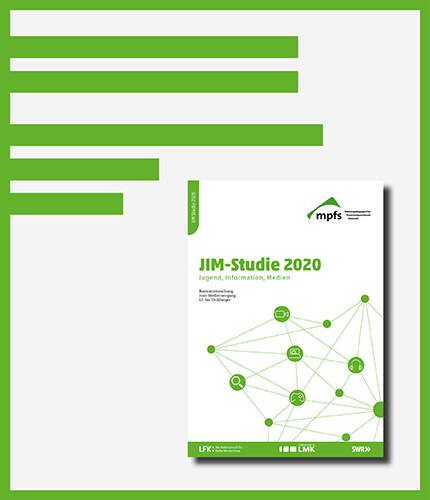JIM Study 2020 on Media Use by Young People Published: Significantly More Media Time in the Corona Year
For the representative study, 1,200 young people aged twelve to 19 in Germany were surveyed by telephone or online from June 8 to July 20, 2020.
The key findings at a glance:
- In 2020, young people experienced a significant boost in media device ownership. Personal ownership of a computer or laptop rose from 65 percent to 72 percent, and owning a tablet from 25 percent to 38 percent. One in three young people now has a television with Internet access.
- The special situation of 2020 also resulted in significantly higher media usage times. According to the young people's estimates, daily Internet usage time increased significantly from 205 minutes in 2019 to 258 minutes in 2020. Entertainment accounted for the largest share of online usage, at one-third. Communication (27%) and games (28%) are almost equally important. The smallest share of online time, at eleven percent, is spent searching for information.
- The higher usage time for entertaining content on the net is also reflected in the use of Streaming services streaming. In 2020, 87 percent regularly watch videos on streaming platforms (at least several times a week), compared to 74 percent in the previous year. When it comes to using shows, series and movies online, Netflix and YouTube are in first place among twelve to 19-year-olds.
- In addition to entertainment on the Internet, television also experienced growth among young people: In the self-assessment of twelve to 19-year-olds, the average, weekday television time rose again to more than two hours for the first time in 2020. Looking at the various playout channels for TV content, it is clear that 45 percent of young people regularly (at least several times a week) use traditional linear TV - i.e. TV content at the time it is broadcast on the TV set. One in five regularly watches content in TV broadcasters' media libraries. 14 percent regularly use recorded TV shows and 13 percent watch shows via live stream on the Internet.
- The average usage time of digital gamesalso increased by 40 minutes to 121 minutes in 2020. Here, differences between the sexes are even more apparent than before: boys play games for 159 minutes, almost twice as long as girls (81 minutes).
- As far as communication among young people is concerned, WhatsApp remains the most important online service. 94 percent of young people use WhatsApp at least several times a week to communicate with others. 87 percent of students have a WhatsApp group with their class.
- Instagram is used by 72 percent of young people at least several times a week - with an upward trend. Snapchat, Pinterest and Twitter are also showing increases compared to the previous year. One of the biggest winners, however, is the Chinese platform TikTok, where regular use has increased by 19 percentage points. Currently, one in four boys and two in five girls communicate regularly via TikTok. One in ten now counts TikTok as one of their favorite online services.
The entire JIM Study 2020 is available for download at mpfs.de.
About the JIM Study
The JIM (Youth, Information, Media) study series has been conducted annually by the Medienpädagogischer Forschungsverbund Südwest (mpfs) in cooperation with Südwestrundfunk (SWR) since 1998. The representative study maps the media behavior of young people in Germany. All editions of the JIM study from 1998 to 2020 are available on the mpfs website.
Further information

